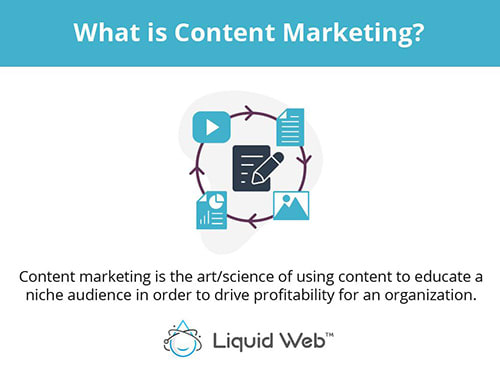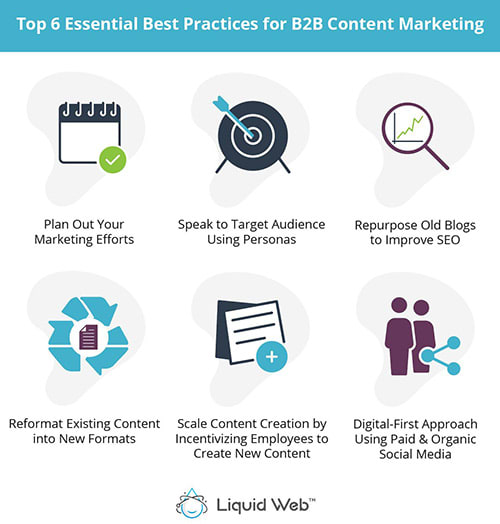Top 6 Effective Best Practices for B2B Content Marketing
The best content marketing strategy doesn’t come out of thin air. It arrives when a foundational approach is taken, scaled, and perfected.
Content marketing is everyone’s game now. There’s more content being created and promoted than ever before. At this point, 91% of B2B marketers are using content marketing.
How do you plan to cut through the noise of your competitors’ content?
It’s not just about creating more content (which is important) or amazing content (which is also true). It's about creating a process that can be executed at scale.
Here’s how:

What Is Content Marketing?
Content marketing is the art and science of creating content designed to educate a niche audience to drive profitability for a company or organization.
Content marketing materials can consist of the following:
- Blogs
- eBooks
- Webinars
- Videos
- Infographics
- White Papers
- Datasheets
- Podcasts
- Battlecards
Content marketing can even include a combination of the above to create truly interactive content that drives leads.
Difference Between B2B and B2C Content Marketing
B2B and B2C content marketing are relatively similar. Both involve creating content designed to educate specific audiences to take action, namely, to purchase your product or service. The difference between the two types of marketing is that B2C content markets to consumers, whereas B2B markets a business’ products or services to another business.

Top 6 Effective Best Practices for B2B Content Marketing
Here are the six essential best practices for B2B content marketing today:
1. Plan
The absolute most important B2B content marketing best practice is to plan out your marketing efforts, including your content marketing. This includes:
- Creating a Themed Quarterly Content Calendar: Creating a quarterly theme allows you to dive deeper into the theme, create more content around that specific product, and drive more channels to specific gated landing pages or high-quality assets. This also includes large company updates, product launches/refreshes, and website launches.
- Planning Content Around All Stages of the Buyer’s Journey: Ensure as you create content that you create a nice, even mix of awareness, consideration, and decision-stage content. Many organizations get stuck in creating only awareness blogs for SEO or decision white papers and case studies to close deals.
- Planning Content That Aligns With Your Business Objectives: When you get strategic with planning content, you can also start to focus on creating more content that aligns with revenue objectives for specific product lines instead of a broad sweep of topics. This also allows you to capitalize on long-tail keywords and SEO for those assets.
- Finding Important Annual Dates and Celebrations: Don’t forget to look at the calendar for industry-specific dates that could align with content promotion, especially for social media paid and organic promotion. Grab a few fun dates to sprinkle into your social calendar along the way to give your brand more personality.
There’s nothing worse than paying to create (or have created) content that doesn’t match your personas, industry, business objectives, or content needs. Planning upfront eliminates that possibility.
2. Target
Create content that speaks directly to your target audience using your personas. This is your first objective if you don’t have personas built for your B2B marketing initiatives.
Personas are fictional profiles centered around factual information about your target audience, including demographic and psychographic information. This will include the role, gender, race, income, location, motivators, and more.
Armed with this information, you can integrate specific copy points into your blogs, eBooks, and other content marketing materials that talk directly to that persona, which will increase your conversion rate and equip your sales team with high-quality content and leads.
3. Repurpose
Repurposing is the science of refreshing your older blog content with better SEO structure and content to achieve a higher rank on search and an increase in the volume of website traffic.
This will include:
- Updating the title, meta description, and keyword(s) for high-volume short- or long-tail keyword(s), depending on your goal(s). Use Answer the Public or Neil Patel’s UberSuggest tools to help.
- Updating the H1, H2, and H3 headers to ensure you answer the keyword and supporting keywords as fully as possible in your post.
- Optimizing posts with fresh content as necessary to rank.
- Ensuring images have alt text with your keyword in the context of the image and the images are below 100kb for optimal load speeds.
- Ensuring there is at least one CTA per post to drive leads.
- Interlinks to appropriate product pages and other related content to signal to Google how your content relates and allow your reader to navigate your content more effectively.
Don’t change the slug on your content unless it is performing exceptionally poorly, as Google attributes SEO value with content URLs. Also, consider trying to own a specific set of short-tail keywords, and then research what keywords your competitors own and how you can start claiming more content in that space.
4. Expand
The most effective way to expand your content footprint for large enterprise teams with million-dollar budgets and small organizations with small budgets is to reformat existing content into new formats.
If you have a blog post that covers the three most important features of your newest product, consider creating:
- A datasheet that explains those three features in extreme technical detail to your technical persona.
- A video that gives an overview of those three features with an invite to demo the product at the end of the video.
- A slide deck explaining how these features translate to business objectives to upload to SlideShare for your professional persona.
- A set of media cards to share with your original blog on social for more engagement.
- An infographic showing how those three features work to create an amazing experience for the end-user.
With one blog, you can easily create endless ideas for new content, with some being very little to no cost to create. For higher dollar items such as videos and case studies, consider increasing content using internal experts. Ask your sales team what they need most, but also consider what your competitors have to offer in terms of content in ideation about content expansion.
5. Increase
Most companies struggle to scale their content creation to meet sales team demands, lead generation objectives, and site traffic goals. Hiring external agencies to write content is a solution, but it usually comes with a high price tag.
The best way to increase content at scale is to incentivize employees to write content and create videos for your traffic and sales goals.
Dedicate part of your marketing budget set aside for agencies to this cause, pitch the idea to your leadership team, and watch your content scale. Just be sure to have a QA plan in place to ensure your content quality stays consistent.
6. Promote
You can’t count on organic traffic alone (unless you’re a Fortune 100 company) for lead generation and website traffic goals. First, try using paid and organic social media to promote. Other avenues, such as newsletters, email campaigns, traditional advertising methods, or cold-calling can be considered, but a digital-first approach will yield higher results. This is especially true for startups and small businesses.
Drive traffic to a gated landing page with a high-quality asset. Ensure the landing page is designed for conversions. Don’t send traffic to YouTube videos or blogs that don’t contain a specific call-to-action that drives them further down the funnel toward purchase.
Consider using advertising on Google, Facebook, and Ad Network platforms due to their ability to target niche audiences more easily and effectively. Also, keep in mind where your target audience spends most of their time, and focus your ad dollars in that space.
Scaling Content Takes Time
Scaling your B2B content marketing efforts takes time and patience. Utilizing internal experts will expand your influence and reach and drive brand equity. Expanding your content into new formats will allow your audiences to find you in new ways and new audiences to find your content.
Keep up to date with the latest Hosting news.




